On Aug. 11, PRSA’s Member Mondays series turned its focus to one of the most talked-about forces shaping the PR and communications profession: artificial intelligence.
The session, titled “AI and Communications: What You Should Know,” wasn’t about speculating whether AI will impact communications. The consensus among panelists was clear: It already has.
Four leaders with deep expertise in technology, analytics and public relations joined moderator Ray Day, APR, PRSA’s 2025 chair and Stagwell vice chair, and Allison Worldwide executive chair, for a wide-ranging discussion on the promise, pitfalls, and practical applications of AI in communications. The panel included: Amanda Carl Pratt, director, head of communications at Google DeepMind; Steve Mnich, head of product and partner communications at Anthropic; Adam Pratt, director, issues and policy communications at IBM; and Tony Sardella, managing director of data and predictive analytics at Allison Worldwide.
AI as a strategic partner, not a replacement
Amanda Carl Pratt emphasized that AI will not replace communicators, though those who fail to learn and apply it risk being replaced by colleagues who do.
“What makes communicators so valuable is our ability to advise, strategize and leverage our experience to help our leaders make smart decisions,” she said. “So, I do not think AI is going to replace comms people, but I do think we will be replaced by people who know how to leverage the technology. My team at Google DeepMind is really experimenting, building tools, figuring out how we can speed up the mundane administrative tasks so we have more time to do the things that comms humans are best at.”
Adam Pratt described AI as a “thought partner,” particularly in high-stakes environments like crisis management and public policy.
“My view on the technology in our work is that I never do my best work in a vacuum. I always do my best work when I can bounce ideas, approaches and tactics off of really smart people,” he said. “I’ve come to look at AI in our role as a thought partner, a new thought partner, one that’s getting better over time, and one whose capabilities I’ve finally gotten to a point where I see enough sophistication that I am comfortable pulling them into the work that I do on issues in crisis and public policy to highly sensitive areas where the stakes are incredibly high for the company.”
Mnich called AI a “virtual collaborator” capable of supporting both tactical content creation and long-term strategic planning. Those who lean in early, he said, will be positioned for the most innovative work as AI adoption deepens.
“I agree that I don’t think that that these technologies will replace our jobs anytime soon,” he said, “but I absolutely think, and we’re already seeing, that the individuals who are leaning in both at the most tactical level now… will absolutely be those who not only have the most professional opportunity, but likely are those who find themselves doing interesting, novel work as adoption becomes more ubiquitous.”
The data on adoption and risk
Sardella brought hard numbers to the discussion. His research at Allison shows that generative AI adoption in communications has tripled between 2023 and 2024. Today, 85% of communicators report using AI at least some of the time, with common applications including brainstorming, drafting, editing and research.
Sardella also noted that AI-generated or AI-assisted press releases accounted for nearly a quarter of all corporate releases by the end of 2024 — a dramatic shift in workflow norms. In marketing, 68% of professionals are using generative AI, often to accelerate content development and idea generation.
But adoption comes with heightened concerns. In surveys of business leaders, AI oversight and risk management now rank higher than trade wars or supply chain disruptions as perceived threats to brand safety. The risks range from bias and fairness issues to misuse by bad actors, particularly through deepfakes, which have already disrupted financial markets and political discourse.
Here are the slides Sardella shared for more data and insights (find larger versions of the slides at this link):
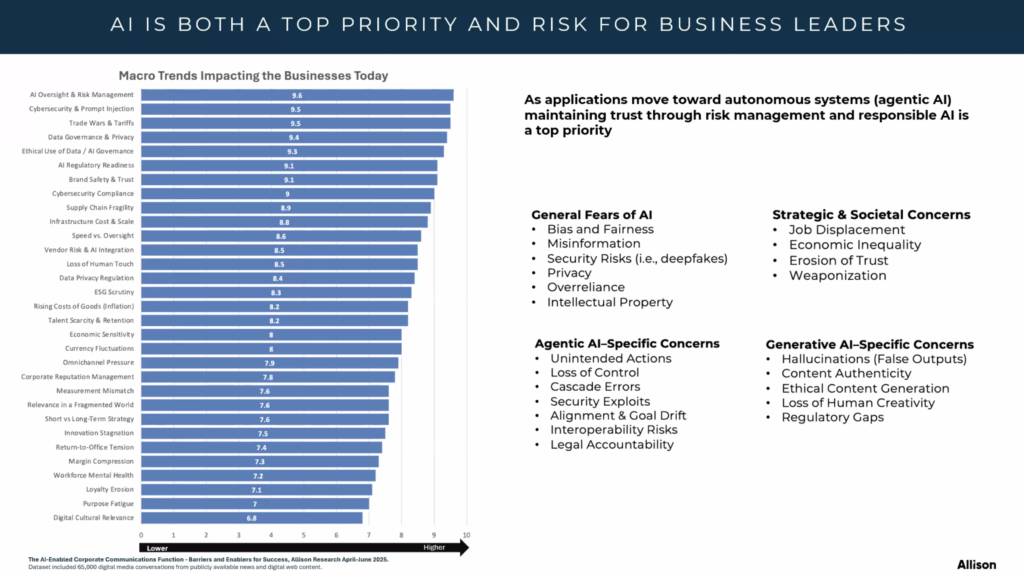
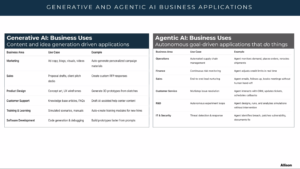
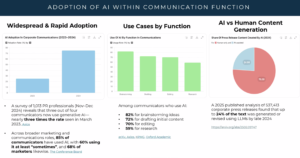
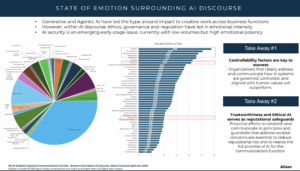
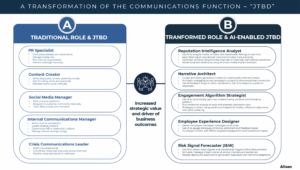
Advice for communicators
Throughout the 45-minute session, several clear recommendations emerged:
-
Experiment and share. “Get your hands on it,” Mnich said. “Understand the differences, have a point of view and share what you learn.”
-
Lead with ethics. “If a company hasn’t published AI principles, that should be a moment of pause,” Adam Pratt said.
-
Keep human strengths at the core. “Don’t lose your humanity,” Amanda Carl Pratt urged. “Your gut, your instinct, your experience — that’s what makes you stand out.”
-
Address external concerns. “Focus on what your constituencies are concerned about,” Sardella said. “That’s how you reduce vulnerability for reputational risk.”
Looking ahead
The panelists agreed that the next 12 months will bring a shift from AI as a content-generation tool to one capable of executing complex, multi-step tasks.
“We’re approaching the point where these tools will do things for you,” Adam Pratt said. “If you’re not ready, the skills gap will be considerable — and it won’t be pleasant.”
As Amanda Carl Pratt reminded attendees, embracing AI doesn’t mean replacing the human voice.
“Make sure the things that make you so valuable still shine through,” she said. “That’s how we’ll stand out as good communicators.”
Watch a replay of the Aug. 11 session below:
Illustration credit: looker_studio







